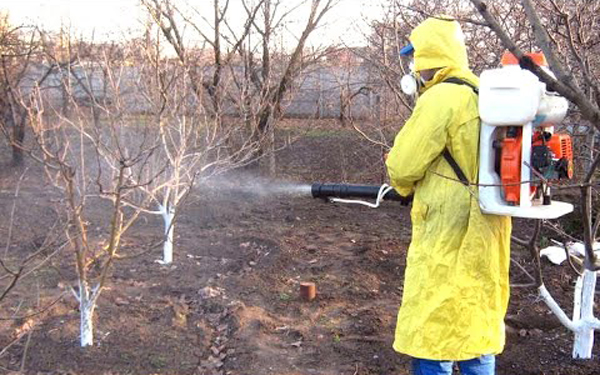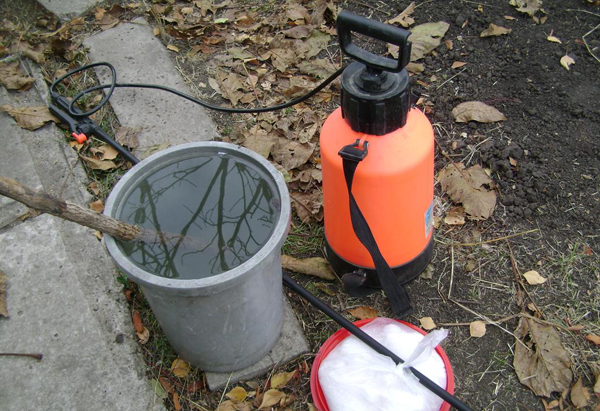Spraying a peach for diseases
Peach is a capricious tree that requires constant attention from a gardener. But if you take proper care of it, carry out agrotechnics on time, you will be rewarded in the form of juicy large fruits, because the peach is one of the three most delicious fruits in the world, along with orange and mango. But in order to taste the harvest, it is necessary to protect the delicate tree from external enemies: diseases and parasites. The article will tell you when and what kind of processing is necessary for your peach to cope with enemies and give a harvest.
Content
Optimal processing time
In order for a peach tree to bear fruit, it needs help: take care of it, fertilize the soil, water it, and also fight various pests and diseases, of which the peach has a lot. It is necessary to spray the peach orchard several times a year, since each spraying aims at a specific task aimed at combating a certain type of pest. Every experienced gardener knows that this tree needs to be processed. Let's take a closer look at the processing periods.
Spring
In the spring, it is imperative to process the peach. Spring processing of peaches is carried out several times: before bud break, on a pink bud and final, after flowering. Each of them has its own tasks, so it will not be possible to process a peach orchard in one spraying.
The first treatment, early, before bud break, is carried out when the temperature no longer drops below +4 degrees. The goal is to destroy a variety of insects hibernating in the bark of a tree or in its shoots. The procedure is carried out in several stages with an interval of 3-4 days. They use fungicides based on copper-containing preparations (Bordeaux liquid, copper sulfate) as well as a solarium emulsion.

Please note that during this period, you should not use preparations based on urea. Since it contains nitrogen, which is an active vegetation stimulant. If such drugs are used before bud breakout, they will accelerate the plant's exit from dormancy, "wake up" it ahead of time, which can lead to disruptions in the further development of the tree up to loss of yield.
Spraying during this period also helps in the fight against curl, the most dangerous enemy of the peach garden. The spores of the fungus hibernate, and then multiply on leaves sprouting from the buds, staining them brown. Young leaves curl, dry up and fall off. As a result, the tree grows worse, does not bear fruit. All the same copper-containing preparations help well against this fungus.
Processing on a pink bud contributes to the fight against various pests, which just at this time come out of hibernation and begin to destroy young foliage, parasitize on the bark. Such spraying is also carried out to prevent such dangerous fungal diseases as powdery mildew, moniliosis or scab. Bordeaux liquid has proven itself well for such operations. Treating it in moderation will not harm your health.
Spraying after flowering is the final stage in the spring treatment of the tree. Has a "fixing" effect, destroying those parasites that survived after the previous two stages.
Summer
Summer treatment is carried out to combat pests that have infested the peach. Urea is perfect for this. This fungicide works well against most parasites. Also, in tandem with it, you can use a variety of insecticides.Remember that all work on spraying drugs must be stopped 20 days before the harvest ripens.
Autumn
Autumn processing is required to suppress the reproduction of fungal spores, because in autumn the most favorable conditions for the development of fungi are formed - high temperature and humidity. If not treated in the fall, then the spring, along with the tree, will meet millions of new fungal spores that have spread to all branches, and the fight against them will require significant effort, money and time. Therefore, do not miss autumn - processing at this time is very important and is done for the future.
It should be noted that the beginning of the first, spring processing depends on the region where the peach grows. In the southern, warm, regions, spraying begins in mid-March, but the farther north you go, the time the procedure starts moving closer to April - it all depends on the average air temperature, which should not fall below +4 degrees Celsius. Further spraying is carried out based on monitoring the growth and development of the tree - the beginning of the growing season, the appearance of the first foliage, buds, fruits.
How to spray - preparations
Peaches have enough enemies, among them the most dangerous are diseases such as leaf curl, moniliosis (fruit rot), coccomycosis, clotterosporia, powdery mildew. In addition to diseases, aphids, weevils, eastern moths, fruit moths and various mites love to "feast" on it. Many drugs have been developed to fight parasites, called fungicides (protection against diseases) and insecticides (protection against insects). Consider the most popular in the fight against pests, spraying with the most effective:
- urea. Urea, actively and effectively dealing with most harmful insects;
- copper-based fungicides, copper sulfate and Bordeaux liquid, are used against most fungal infections;
- fungicide preparations "Abiga-Peak", "Gaupsin", "Planriz", "Skor", "Trichodermin", "Horus", "Tattu". They are used to fight most fungal infections;
- insecticide preparations "Aktara", "Engio", "Actellik". The drugs are used against a variety of insect pests;
- diesel oil emulsion. Effective against insects. If a plant is sprayed with such a mixture, it will become covered with a film that blocks the access of oxygen to various insects hibernating in the bark, which is why they either crawl out or die;
- folk remedies. Tinctures of garlic, lavender or tobacco have long been used against aphids. If you spray a tree with such a solution, insects that cannot tolerate the strong aroma of the drug will leave the tree.
Processing technology
To achieve the maximum effect, spraying should be carried out according to the rules. If you ignore them, then all your efforts may be useless - you will spend the solution, but do not remove the pests.
First of all, in the fall, clean the garden before spraying - collect and burn all the fallen leaves, and also cut off dry and diseased branches, and treat the cuts with garden pitch. In autumn and spring, spraying is carried out on a quiet, clear, windless day, make sure that it does not rain either during or in the next 2-3 days, otherwise it will wash off the chemicals. If this happens, you must repeat the procedure. It is advisable to spray in the morning, after the dew has evaporated, or closer to sunset, when the weather is calm. In the spring, during the growing season, if there is no dew at night and your garden is lit, the procedure can be carried out at night. It is necessary to achieve the smallest possible spraying of the solution, while treating the entire surface of the tree: trunk, branches, foliage on both sides.

The first spraying in early spring against insects hibernating in the bark should be carried out using a watering can with large holes.Thus, we supply the plant with the maximum volume of solution, simply pouring it in so that water can get into even the smallest crevices, without having time to absorb or evaporate, and at the same time killing all parasites.
It is worth noting that gardeners often use complex measures in pest control, spraying peach orchards with a mixture of fungicides and insecticides, which is equally good at destroying both fungal parasites and insects. Also, do not spray with the same drugs - the pests adapt quickly. Use different chemicals - the selection of samples on the market is quite large.
The ability to start spraying on time, choosing the right preparations, can save your peach from death. And knowledge of the spraying rules will save you from unnecessary financial expenses for the repeated purchase of drugs and will contribute to the fact that the peach crop will be born on time and in full.
Peach Spray Video
This video will show you how to spray a peach.
